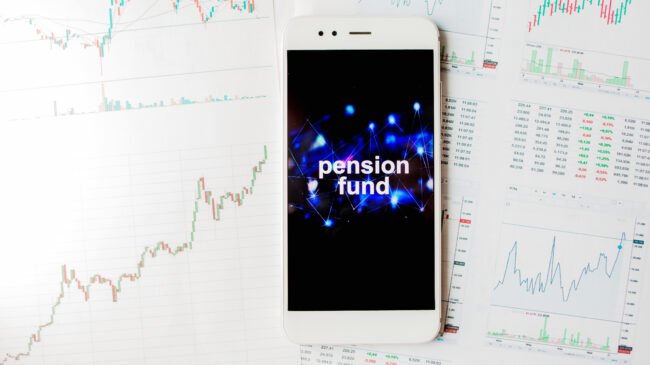According to forecasting by Reason Foundation’s Pension Integrity Project, when the fiscal year 2022 pension financial reports roll in, the unfunded liabilities of the 118 state public pension plans are expected to again exceed $1 trillion in 2022. After a record-breaking year of investment returns in 2021, which helped reduce a lot of longstanding pension debt, the experience of public pension assets has swung drastically in the other direction over the last 12 months. Early indicators point to investment returns averaging around -6% for the 2022 fiscal year, which ended on June 30, 2022, for many public pension systems.
Based on a -6% return for fiscal 2022, the aggregate unfunded liability of state-run public pension plans will be $1.3 trillion, up from $783 billion in 2021, the Pension Integrity Project finds. With a -6% return in 2022, the aggregate funded ratio for these state pension plans would fall from 85% funded in 2021 to 75% funded in 2022.
The 2022 Public Pension Forecaster below allows you to preview changes in public pension system funding measurements for major state-run pension plans. It allows you to select any potential 2022 investment return rate to see how the returns would impact the unfunded liabilities and funded status of these state pension plans on a market value of assets basis.
The nation’s largest public pension system, the California Public Employees’ Retirement System (CalPERS), provides a good example of how much one bad year of investment returns can significantly impact unfunded liabilities, public employees, and taxpayers.
If CalPERS’ investment returns come in at -6% for 2022, the system’s unfunded liabilities will increase from $101 billion in 2021 to $159 billion in 2022, a debt that would equal $4,057 for every Californian. Its funded ratio will drop from 82.5% in 2021 to 73.6% in 2022, meaning state employers will have less than three-quarters of the assets needed to pay for pensions already promised to workers.
Similarly, the Teacher Retirement System of Texas (TRS) reported $26 billion in unfunded liabilities in 2021. If TRS posts annual returns of -6% for the fiscal year 2022, its unfunded liabilities will jump to $40 billion, and its funded ratio will drop to 83.4%. The unfunded liability per capita is estimated to be $1,338.
The table below displays the estimated unfunded liabilities and the funded ratios for each state if their public pension systems report -6% or -12% returns for 2022.
Estimated Changes to State Pension Unfunded Liabilties, Funded Ratios
| Unfunded Pension Liabilities (in $ billions) | Funded Ratio | |||||
|---|---|---|---|---|---|---|
| 2021 | 2022 (if -6% return) | 2022 (if -12% return) | 2021 | 2022 (if -6% return) | 2022 (if -12% return) | |
| Alabama | $13.03 | $19.02 | $21.72 | 78% | 69% | 64% |
| Alaska | $4.48 | $6.67 | $7.77 | 81% | 72% | 67% |
| Arizona | $22.85 | $30.72 | $34.44 | 73% | 65% | 61% |
| Arkansas | $1.60 | $5.67 | $7.64 | 95% | 84% | 79% |
| California | $131.57 | $232.98 | $285.57 | 87% | 78% | 73% |
| Colorado | $22.37 | $29.64 | $33.07 | 72% | 64% | 60% |
| Connecticut | $37.60 | $42.34 | $44.89 | 53% | 48% | 45% |
| Delaware | ($1.17) | $0.29 | $1.06 | 110% | 98% | 91% |
| Florida | $7.55 | $31.86 | $43.77 | 96% | 85% | 80% |
| Georgia | $10.79 | $24.80 | $31.83 | 92% | 81% | 76% |
| Hawaii | $11.94 | $14.81 | $16.13 | 65% | 58% | 55% |
| Idaho | ($0.02) | $2.58 | $3.87 | 100% | 89% | 83% |
| Illinois | $121.25 | $142.68 | $152.70 | 58% | 52% | 49% |
| Indiana | $10.11 | $12.75 | $14.50 | 74% | 68% | 64% |
| Iowa | ($0.12) | $5.41 | $8.14 | 100% | 89% | 83% |
| Kansas | $5.70 | $8.65 | $10.15 | 82% | 73% | 68% |
| Kentucky | $36.22 | $42.11 | $44.54 | 53% | 47% | 44% |
| Louisiana | $11.57 | $17.55 | $20.75 | 82% | 74% | 69% |
| Maine | $1.46 | $3.49 | $4.60 | 93% | 83% | 78% |
| Maryland | $12.97 | $20.31 | $24.10 | 83% | 74% | 70% |
| Massachusetts | $31.68 | $41.27 | $45.57 | 70% | 62% | 58% |
| Michigan | $39.41 | $48.78 | $53.68 | 68% | 61% | 57% |
| Minnesota | $0.68 | $11.31 | $16.36 | 99% | 87% | 82% |
| Mississippi | $14.99 | $19.73 | $21.80 | 70% | 62% | 58% |
| Missouri | $7.79 | $17.43 | $22.17 | 91% | 81% | 76% |
| Montana | $2.67 | $4.22 | $4.95 | 82% | 73% | 68% |
| Nebraska | ($0.88) | $0.98 | $1.88 | 106% | 93% | 87% |
| Nevada | $9.12 | $17.71 | $21.15 | 87% | 75% | 70% |
| New Hampshire | $4.54 | $5.90 | $6.59 | 72% | 65% | 60% |
| New Jersey | $80.50 | $92.28 | $98.04 | 55% | 49% | 46% |
| New Mexico | $12.13 | $16.48 | $18.50 | 74% | 65% | 61% |
| New York | ($46.11) | $2.19 | $26.22 | 113% | 99% | 93% |
| North Carolina | $0.09 | $12.95 | $20.29 | 100% | 90% | 84% |
| North Dakota | $2.10 | $2.99 | $3.42 | 78% | 69% | 65% |
| Ohio | $34.83 | $63.10 | $76.52 | 87% | 77% | 72% |
| Oklahoma | $4.14 | $8.82 | $11.24 | 91% | 81% | 76% |
| Oregon | $7.85 | $18.96 | $23.91 | 91% | 80% | 75% |
| Pennsylvania | $56.19 | $68.43 | $75.13 | 67% | 60% | 56% |
| Rhode Island | $4.29 | $5.35 | $5.93 | 70% | 63% | 59% |
| South Carolina | $24.01 | $28.93 | $31.29 | 62% | 56% | 52% |
| South Dakota | ($0.77) | $0.95 | $1.82 | 106% | 93% | 87% |
| Tennessee | $10.22 | $16.59 | $19.32 | 82% | 72% | 67% |
| Texas | $44.48 | $83.65 | $102.30 | 88% | 78% | 73% |
| Utah | $1.11 | $5.72 | $7.90 | 97% | 85% | 80% |
| Vermont | $2.72 | $3.40 | $3.74 | 68% | 62% | 58% |
| Virginia | $5.97 | $17.08 | $22.94 | 94% | 84% | 79% |
| Washington | ($19.60) | ($7.21) | ($0.56) | 122% | 107% | 101% |
| West Virginia | $0.27 | $2.44 | $3.54 | 99% | 87% | 82% |
| Wisconsin | ($15.32) | $0.52 | $8.38 | 113% | 100% | 93% |
| Wyoming | $2.00 | $3.06 | $3.58 | 81% | 72% | 68% |
| Total | $782.81 | $1,308.32 | $1,568.83 |
The first three quarters of the 2022 fiscal year clocked in at 0%, 3.2%, and -3.4% for public pensions, according to Milliman. The S&P 500 is down more than 20% since January, suggesting that the fourth quarter results will be more bad news for pension investments.
Considering the average pension plan bases its ability to fund promised benefits on averaging 7% annual investment returns over the long term, plan managers are preparing for significant growth in unfunded liabilities, and a major step back in funding from 2021.
The significant levels of volatility and funding challenges pension plans are experiencing right now support the Pension Integrity Project’s position last year that most state and local government pensions are still in need of reform, despite the strong investment returns and funding improvements in 2021. Unfortunately, many observers mistook a single good year of returns—granted a historic one—as a sign of stabilization in what was a bumpy couple of decades for public pension funding. On the contrary, this year’s returns, as well as the growing signs of a possible recession, lend credence to the belief that public pension systems should lower their return expectations and view investment markets as less predictable and more volatile.
State pension plans, in aggregate, have struggled to reduce unfunded liabilities to below $1 trillion ever since the Great Recession, seeing this number climb to nearly $1.4 trillion in 2020. Great results from 2021 seemed to finally break this barrier, with the year’s historically positive investment returns reducing state pension debt to about $783 billion. Now, state-run pension plans will again see unfunded liabilities jump back over $1 trillion, assuming final 2022 results end up at or below 0%.
It is important not to read too much into one year of investment results when it comes to long-term investing. But during this time of economic volatility, policymakers and stakeholders should recognize that many of the problems that kept public pension systems significantly underfunded for multiple decades still exist. And many pension plans are nearly as vulnerable to financial shocks as they were in the past.
Going forward, state and local leaders should continue to seek out ways to address and minimize these risks, making their public retirement systems more resilient to an uncertain future.
Webinar on using the 2022 Public Pension Forecaster:
Stay in Touch with Our Pension Experts
Reason Foundation’s Pension Integrity Project has helped policymakers in states like Arizona, Colorado, Michigan, and Montana implement substantive pension reforms. Our monthly newsletter highlights the latest actuarial analysis and policy insights from our team.



